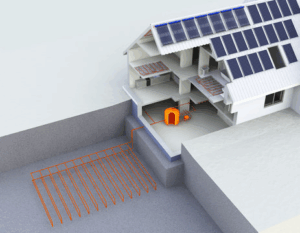With the continued discussion about climate change, and the increased interest in renewable energy worldwide, there is a strong interest in geothermal energy. Geothermal energy, in general, uses temperatures underground to create carbon-free electricity, heating, and cooling. Like solar power which works best in areas where there are significant sunny days, geothermal works best under certain underground circumstances.
For Western Canada, and specifically Alberta, the geothermal energy opportunities are extensive, and nearly province wide. This isn’t new information: A study conducted a decade ago mapped the geothermal resources of Canada. The maps created by this survey show western Canada, including Alberta to be the near-perfect place for the use of geothermal technology.
There is geothermal, and there is geothermal
To be clear, the study and the maps it produced focus on geothermal energy production. While the overall concept is the same, this is different from using a Ground Source Heat Pump (GSHP) to heat and cool a home. Same technology, but different output. Same concept, but on a different scale.
Want to know more about Heating and Cooling with Geothermal?
A GSHP exchanges heat underground, pushing it out of homes to cool them in summer, and drawing that heat energy back out in the winter to heat. A GSHP will use electricity as part of the system to heat and cool a home, with piping that could be buried as much as 100 meters below the surface. At the other end of the geothermal spectrum is the geothermal power plant, which uses the difference in temperatures far below the surface to directly generate electricity. The depth of the piping required for this is not measured in meters but in kilometers. The maps drawn from the geothermal study are estimating heat energy 6.5 kilometers down.
Geothermal energy is just getting started in Canada. The very first geothermal plant is nearing completion in Saskatchewan and will provide enough carbon-free electricity to power 20,000 homes.
Why Western Canada For Geothermal Energy ?
Geothermal technology, whether for power generation or heating and cooling homes and buildings can be successful anywhere in Canada, but it is quite apparent that the most significant heat energy resource is in Alberta and Western Canada. That’s the result of Alberta’s proximity to the Ring of Fire.
The Ring of Fire is the name given to the tectonic plate boundaries along the edge of the Pacific Ocean. The Ring of Fire is home to 75% of the world’s volcanoes, The greater the geothermal activity, the better suited for geothermal technology.
What’s good for the (Canada) Goose…. (sorry…couldn’t resist)
Geothermal energy production takes this technology to another level and comes with a commensurate price tag, but the data provided can be applicable to the homeowner, homebuilder, or developer who is considering installing a geothermal heating and cooling system, with the same attributes of significantly reducing the use of fossil fuels. In the case of a GSHP, the cost savings are there, experienced through reduced operating costs and increased system longevity.
The use of geothermal exchange systems in Canadian homes and businesses is growing. In the last few years, the number of Canadians installing this type of system has grown to over 850,000 homes. In Alberta and western Canada, geology and geography will always make geothermal technology the better answer.
Envirotech Geothermal proudly serves the Lakeland, Calgary, and Edmonton, Alberta regions including Canmore and Rockyview helping homeowners and builders to discover the benefits and features of geothermal heating and cooling. Contact us today to learn how you can save up to 70% on your heating and cooling bills by utilizing geothermal heating and cooling in your home. Call us at 780.220.0842 or request a Geothermal Consultation for more information.



